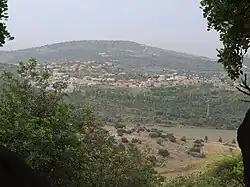Kfar Hananya
Kfar Hananya (Hebrew: כְּפַר חֲנַנְיָה) is a community settlement in the Galilee in northern Israel under the administration of the Merom HaGalil Regional Council. In 2021 it had a population of 762.[1]The village marks the border between the historic Upper and Lower Galilee regions. Lower Galilee is defined in the Mishnah (Shevi'it 9:2) as the area south of Kfar Hananya where the Sycamore Fig tree grows (Ficus sycomorus).
Kfar Hananya
כְּפַר חֲנַנְיָה | |
|---|---|
 | |
| Etymology: Hananya village | |
 Kfar Hananya  Kfar Hananya | |
| Coordinates: 32°54′57″N 35°25′21″E | |
| Country | Israel |
| Affiliation | Hapoel HaMizrachi |
| Founded | 1977 |
| Founded by | Hapoel HaMizrachi |
| Population (2021)[1] | 762 |
Name
The village is named after the ancient village of the same name, a little further to its north, which is mentioned in the Mishnah.[2]
History
Antiquity
Ancient Kfar Hananya was a Jewish village during the period of Roman and Byzantine rule in the Galilee. It was a center of pottery production in the Galilee and most of the cooking ware in the Galilee between the 1st century BCE and the beginning of the 5th century CE was produced there.[3][4] It is mentioned for its pottery production in Rabbinic literature. Archaeological excavations revealed shafts and bases of columns, caves, a pool, and a burial ground.
The village was mentioned in various accounts throughout the following centuries. A 12th century Jewish visitor wrote of the ruins of a synagogue quarried into the hill.[5] In 1522, the Jewish traveller Moses ben Mordecai Bassola found about 30 families of Musta'arabi Jews living there, most of them of priestly stock, making it the fifth-largest Jewish community in the country at the time, out of eight places named by him.[6] A 1525 Ottoman census recorded 14 Jewish families in the village.
Ottoman era
After the Ottoman Empire conquered Palestine, the village came to be known as Kafr 'Inan and very soon became an all-Muslim village. In Ottoman tax records from either 1549 or 1596 it was described as a village with an entirely Muslim population estimated at 259.[7] In 1881, the PEF Survey of Palestine described it as a Muslim village of 150-200 residents.[8]
British Mandate
During the British Mandate era, Kafr 'Inan was recorded as having an all-Muslim population of 360 in the 1945 Village Statistics. During the 1948 Arab-Israeli War, Kafr 'Inan was captured by the Golani Brigade of the Israel Defense Forces as part of Operation Hiram and the area was subsequently incorporated into the State of Israel. The villagers were expelled.[9]
State of Israel
Modern Kfar Hananya was founded in 1977 as a moshav of the movement Hapoel HaMizrachi for members of nearby moshavim on land that belonged to Kafr 'Inan, about 1 km south of the village site. In 1992 it became a community settlement. A new neighborhood built in the 2000s is called "Maale Hen" (מעלה חן).
Landmarks
Near the community is a burial place attributed to Rabbi Hananya ben Akashya,[10][11] a sage of the Tannaim period.
The ruins of ancient Kefar Hanania are situated about one kilometre north of the modern village.[12] Kefar Hanania is mentioned in the Mishnah as a community on the border between the Lower Galilee and Upper Galilee (Mishnah Shevi'it 9:2).[2][13]
Archaeology
Kfar Ḥananya ware, produced in Kfar Hananya from the mid-first century BCE to the mid-fifth century CE, is the ceramic marker of Roman Galilee. Kfar Ḥananya potters manufactured vessels for cooking and household use in seven general forms: shallow pans, bowls, casseroles, cooking pots, jugs and small storage jars. [14]In the Babylonian Talmud, Rabbi Jose ben Halafta praises the vessels produced in Kfar Hananya, describing them as “not likely to burst.” [15]
References
- "Regional Statistics". Israel Central Bureau of Statistics. Retrieved 22 February 2023.
- Aviam, Mordechai; Richardson, Peter (2003). "Flavius Josephus: Life of Josephus, translated and commented by Steve Mason, Appendix A". Josephus' Galilee in Archaeological Perspective. Brill. ISBN 9780391042056. Retrieved 25 May 2018.
The border between Upper and Lower Galilee mentioned by the Mishnah is at Kefar Hananiah, but Josephus locates the border at Bersabe, which he uses as a reference point for his list of border towns (Life 188). The two sites are located side by side within a distance of less than a kilometer, at the eastern end of the Beth Kerem valley.
- Negev, Avraham; Gibson, Shimon (2001). "Kefar Hananyah". Archaeological Encyclopedia of the Holy Land. New York and London: Continuum. p. 279. ISBN 0-8264-1316-1. Retrieved 24 April 2021.
- Crossan, John Dominic (1999). Birth of Christianity. Edinburgh: T&T Clark. p. 224. ISBN 978-0-567-08668-6. Retrieved 24 April 2021.
- The Ancient Synagogues in Galilee
- Braslavski (1933-07-01). "Kefar Hanania / כפר חנניה: על יסוד פרטים שנאספו בשעת סיור". Bulletin of the Jewish Palestine Exploration Society / ידיעות החברה העברית לחקירת ארץ-ישראל ועתיקותיה (in Hebrew). 1 (2). p. 20. ISSN 2312-0096. JSTOR 23718865.
- "The Administration and Population of the Sancak of Safed in the Sixteenth Century | Harold Rhode - Academia.edu". Archived from the original on 2019-04-20. Retrieved 2020-08-22.
- "The survey of western Palestine : Memoirs of the topography, orography, hydrography, and archaeology".
- Morris, Benny (2004). The Birth of the Palestinian Refugee Problem Revisited. Cambridge Middle East Studies. Vol. 18. Cambridge University Press. p. 517. ISBN 9780521009676. ISSN 1365-5698. Retrieved 24 April 2021.
- Ḥadad, David (2005). Sefer Ma'asei Avoth (in Hebrew). Beer-Sheva. p. (Appendix). OCLC 74311775.
{{cite book}}: CS1 maint: location missing publisher (link) - Encyclopedia of Kivrei Tzadikim
- David Adan-Bayewitz, Kefar Hananya, Israel Exploration Journal 37 (1987), pp 178-179; Adan-Bayewitz, D., "Kefar Hananya", New Encyclopedia of Archaeological Excavations in the Holy Land, (ed. E. Stern), 2008, pp. 1909-1911
- The Mishnah (ed. Herbert Danby), Oxford University Press: Oxford 1933, s.v. Tractate Shebiit 9:2
- Kefar Hananya ware
- New Israeli Computer Tech Puts the Pieces Together for Pottery Archaeologists, Haaretz